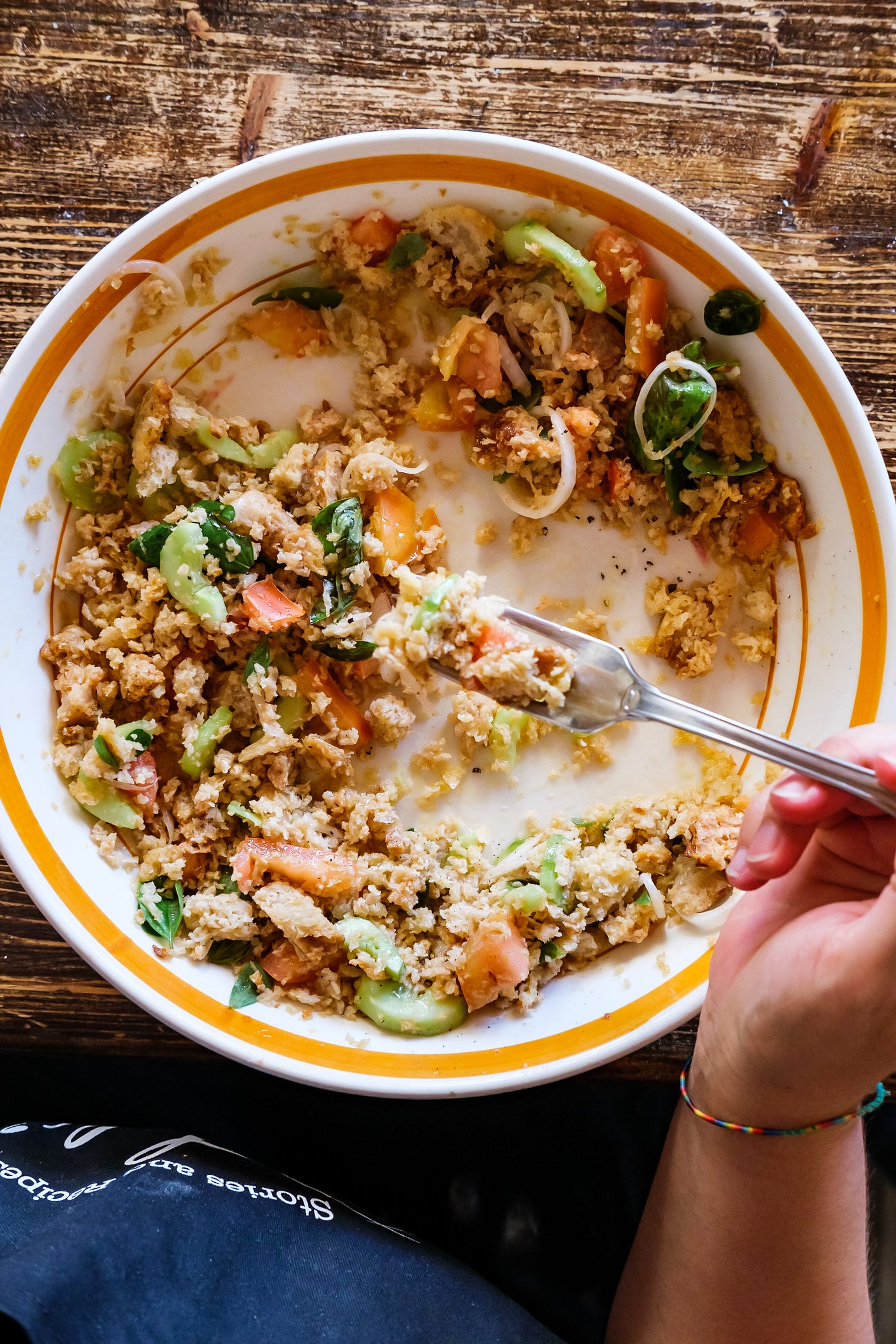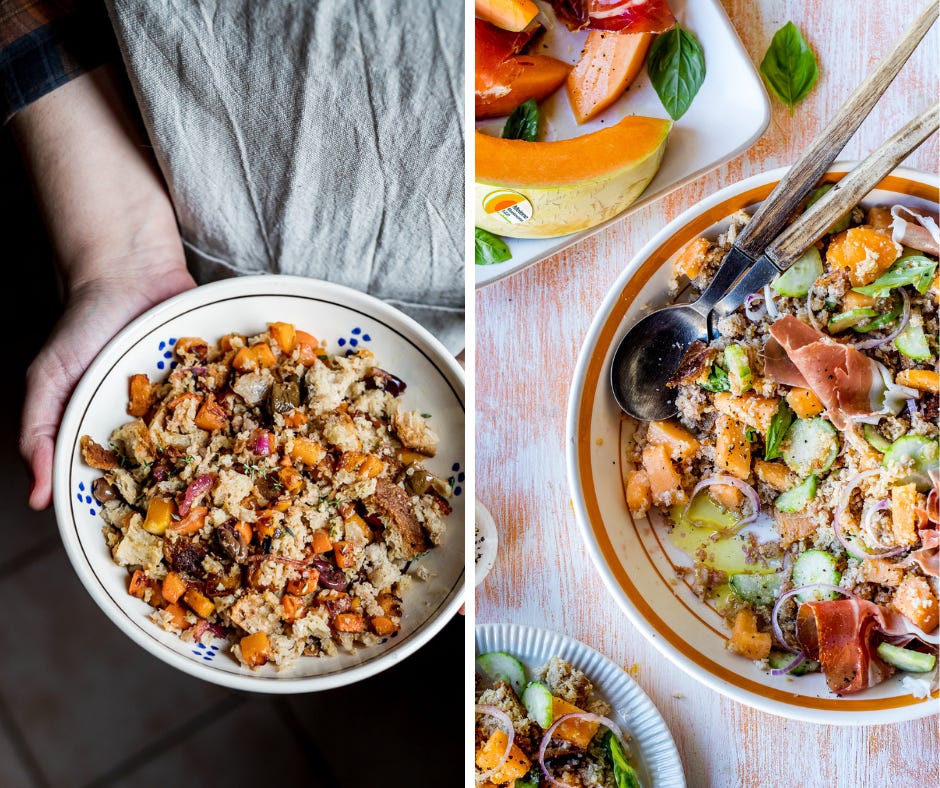Anatomy of a bread salad
The Tuscan panzanella and the Roman panzanella | Acquasale in Apulia | Cialledda fredda in Matera and ciaudella in Abruzzo | Cundigiun and capponada in Liguria
This summer I made panzanella very often. I think it was due to the combination of availability of plenty of sourdough bread gone stale, and an abundance of seasonal produce from the garden: ripe heirloom tomatoes, fresh onions, crisp cucumbers, and handfuls of fresh basil leaves.
I had panzanella at home in Tuscany countless times, then I tasted a surprisingly similar acquasale in Puglia. Whenever there was stale bread and an abundance of seasonal produce, the regional cucina povera came out with nourishing, filling recipes to give a second life to day-old bread.
Today, I’m taking you on a tour, we’ll explore the different bread salads of the Italian cucina povera through their ingredients, traditions, and recipes.
Panzanella, the Tuscan bread salad
Known since Boccaccio’s time as “washed bread,” this ancient Tuscan recipe was later immortalized by Renaissance painter and poet Bronzino (1503-1572), who wrote of a green panzanella made with onion, cucumber, purslane and arugula. Tomatoes were not included, as they had just been introduced to Europe from the Americas and were not yet commonplace.
Chi vuol trapassar sopra le stelle / en’tinga il pane e mangia a tirapelle / un’insalata di cipolla trita / colla porcellanetta e citriuoli / vince ogni altro piacer di questa vita / considerate un po’ s’aggiungessi bassilico / e ruchetta.
In my family, we tend to make the classic panzanella, without exception. But then friends arrive, each wanting a different version. Some want a panzanella without onion, others prefer it without cucumber. Panzanella is one of those dishes that invariably bend to the mood of the day and what’s on hand in the garden or pantry.
Let’s have a look at its essential ingredients
The most essential ingredient is Tuscan bread which has gone stale by a few days. Tuscan bread is made without salt and has a dense, bland crumb and a dark crust. The best option would be a sourdough loaf baked in a wood-burning oven. It is roughly cut into chunks, then soaked in water, squeezed out to remove the excess water, and crumbled into a large bowl. This is not how everyone in Tuscany makes it (as someone soaks the bread directly with the vegetables’ water), but this is how my grandma has been making it for all her life.
This is the essential step in the making of panzanella: stale bread, either soaked in water, water acidulated with some vinegar, or just in the vegetables’ moisture, but not bread croutons. Never. I see the point of using crunchy, golden bread croutons to make a tasty bread salad, but that is not a panzanella.
The bread is then tossed with tomatoes, cucumbers, and thinly sliced red onion. As for the dressing, opt for your best extra virgin olive oil (our olive oil is intense and slightly bitter), salt, freshly ground black pepper, and a drizzle of red wine vinegar. Vinegar is essential, it is what gives panzanella its refreshing taste, making it the perfect summer dish. A handful of fresh basil leaves add the last finishing touch to panzanella.
Other possible ingredients? Celery, arugula, purslane, olives, capers, and even canned tuna, mozzarella and boiled eggs.
Here’s my recipe for panzanella on the blog.
I’ve played with the ingredients of panzanella in recent years, as the crumbled soaked bread is the perfect canvas to absorb seasonal flavours and elevate them to a filling, nutritious dish.
Last week, for example, I shared a prosciutto and melon panzanella, born from the marriage of two Italian summer classics. You can read more about it on the blog.
You can also make an autumn panzanella salad with pan-fried butternut squash and carrots, a handful of meaty olives, and caramelized red onions to add a sweet and sour touch. When it comes to dressing the salad, opt for a lighter apple cider vinegar that won’t steal the show to freshly pressed extra virgin olive oil, olio nuovo, that will release all its peppery aromas when it will get in contact with the hot vegetables. This is the recipe on the blog.
But bread salads are not a prerogative of Tuscany. With different names and a variety of local and seasonal ingredients, they are widespread in most of the central and southern regions of Italy.
What they all have in common is a peasant origin and the use of day-old bread, upcycled into a new, filling, seasonal recipe.
Now let's do a roundup of the most fascinating recipes I found for preparing other types of bread salad from cucina povera: Panzanella romana, Acquasale in Puglia, cold Cialledda in Matera and ciaudella in Abruzzo, and finally Cundigiun and capponada in Liguria.





